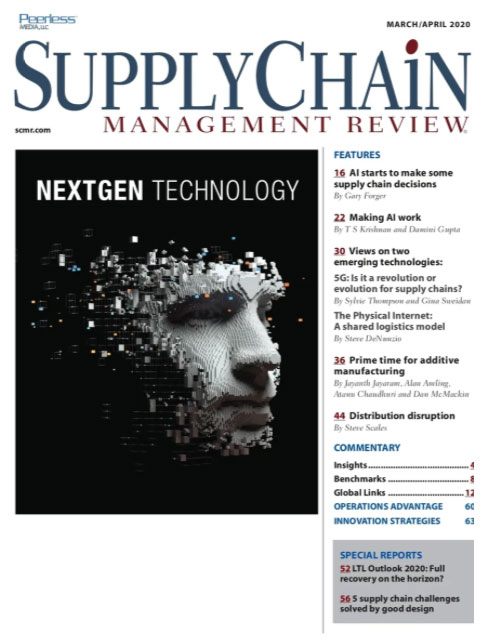Sorry, but your login has failed. Please recheck your login information and resubmit. If your subscription has expired, renew here.
March-April 2020
Are you ready for NextGen technologies? Just the other day, I had the opportunity to tour one of Amazon’s highly automated robotic fulfillment centers. I expected to be dazzled—and I was. But it wasn’t because of the automation. The tour was a reminder that there’s no question that NextGen technologies such as Artificial Intelligence, blockchain, robotics, 3D printing and 5G are going to be the differentiators in tomorrow’s supply chain. The question is: Are you ready? Browse this issue archive.Need Help? Contact customer service 847-559-7581 More options
The path to sustainable supply chains may be ill-defined, but chances are it’s circular. Companies are coming under increasing pressure to reduce waste by redesigning, recycling or repurposing end-of-life products, processes that are core to circular supply chains. However, embracing circularity across supply chains designed primarily to move product forward in a linear fashion is a massive undertaking that entails changing deeply ingrained practices. How can companies engineer this course change without undermining the performance levels they have worked so hard to achieve in the linear world?
Such a change requires much innovation. In December 2019, some 40 companies from various industries gathered at the MIT Center for Transportation & Logistics’ (MIT CTL) Towards Circularity in the Supply Chain Roundtable to discuss the innovative approaches companies need to create closedloop supply chains.
Mapping a circular route
The Ellen Macarthur Foundation defines a circular economy as “a framework for an economy that is restorative and regenerative by design.” The model is based on three principles: design out waste and pollution, keep products and materials in use and regenerate natural systems. Supply chain management is fundamental to achieving the first two principles.

This complete article is available to subscribers only.
Log in now for full access or start your PLUS+ subscription for instant access.
SC
MR
Sorry, but your login has failed. Please recheck your login information and resubmit. If your subscription has expired, renew here.
March-April 2020
Are you ready for NextGen technologies? Just the other day, I had the opportunity to tour one of Amazon’s highly automated robotic fulfillment centers. I expected to be dazzled—and I was. But it wasn’t because… Browse this issue archive. Access your online digital edition. Download a PDF file of the March-April 2020 issue.The path to sustainable supply chains may be ill-defined, but chances are it's circular. Companies are coming under increasing pressure to reduce waste by redesigning, recycling or repurposing end-of-life products, processes that are core to circular supply chains. However, embracing circularity across supply chains designed primarily to move product forward in a linear fashion is a massive undertaking that entails changing deeply ingrained practices. How can companies engineer this course change without undermining the performance levels they have worked so hard to achieve in the linear world?
Such a change requires much innovation. In December 2019, some 40 companies from various industries gathered at the MIT Center for Transportation & Logistics' (MIT CTL) Towards Circularity in the Supply Chain Roundtable to discuss the innovative approaches companies need to create closedloop supply chains.
Mapping a circular route
The Ellen Macarthur Foundation defines a circular economy as “a framework for an economy that is restorative and regenerative by design.” The model is based on three principles: design out waste and pollution, keep products and materials in use and regenerate natural systems. Supply chain management is fundamental to achieving the first two principles.
SC
MR


Latest Supply Chain News
- Is the market stabilizing? Shippers are optimistic
- Supplier, vendor inequality hinders supply chain’s competitive edge
- 5 strategies for energy market cost and risk reduction
- 5 strategies for energy market cost and risk reduction
- Managing inflationary price risks in supplier-buyer contracts through indexing
- More News
Latest Podcast

 Explore
Explore
Business Management News
- Is the market stabilizing? Shippers are optimistic
- 5 strategies for energy market cost and risk reduction
- 5 strategies for energy market cost and risk reduction
- Managing inflationary price risks in supplier-buyer contracts through indexing
- Balanced supply chain management: Setting the stage
- Top 50 Trucking: Accept the challenge and adapt
- More Business Management
Latest Business Management Resources

Subscribe

Supply Chain Management Review delivers the best industry content.

Editors’ Picks






